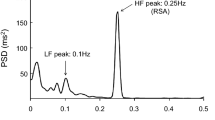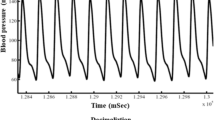Abstract
Baroreceptor sensitivity (BRS) is considered a powerful prognostic factor in cardiovascular health. This study investigated the possibility of modifying the baroreflex cardiac function through biofeedback. Thirty-two psychology students underwent 3 biofeedback sessions, with four 5-min trials each, in which they had to increase and decrease baroreflex function. BRS was assessed by a system that analyzed baroreflex cardiac function on-line using a noninvasive spontaneous sequence method in the time domain. Baroreceptor parameters were differentiated in terms of blood pressure increases (“up” sequences) or blood pressure decreases (“down” sequences). BRS in the “up” sequences increased during the Increase Condition and decreased during the Decrease Condition. BRS in the “down” sequences decreased during the Decrease Condition but was unchanged during the Increase Condition. The increase in BRS during the Increase Condition was associated with a significant reduction in blood pressure and increase in heart period. The opposite cardiovascular changes were observed during the Decrease Condition. Suggestions for future research were discussed.
Similar content being viewed by others
REFERENCES
Berntson, G. G., Bigger, J. T., Eckberg, D. L., Grossman, P., Kaufmann, P. G., Malik, M., et al. (1997). Heart rate variability: Origins, methods, and interpretative caveats. Psychophysiology, 34 ,623–648.
Bertinieri, G., di Rienzo, M., Parati, B., Pomidossi, G., Pedotti, A., Zanchetti, A., et al. (1987). Baroreceptor-heart rate reflex studied in normotensive and essential hypertensives by beat-to-beat analysis of 24-hour blood pressure and heart rate. Journal of Hypertension, 5 ,5333–5335.
Conway, J. (1984). Hemodynamic aspects of essential hypertension in humans. Physiological Reviews, 64 ,617–660.
de Boer, R. W., Karemaker, J. M., & Strackee, J. (1987). Hemodynamic fluctuations and baroreflex sensitivity in humans: A beat-to-beat model. American Journal of Physiology, 249 ,H867–H875.
Eckberg, D. L., Kifle, Y. T., & Roberts, V. L. (1980). Phase relationship between human respiration and baroreflex responsiveness. Journal of Physiology, 304 ,489–502.
Eckberg, D. L., & Sleight, P. (1992). Human baroreflexes in health and disease. Oxford, UK: Oxford University Press.
Engel, B. T., & Joseph, J. A. (1982). Attenuation of baroreflexes during operant cardiac conditioning. Psychophysiology, 19 ,609–614.
González, M. I., & Reyes del Paso, G. A. (1999). Self-control of baroreceptor cardiac reflex sensitivity. Psychophysiology, 36 ,S55.
Gribbin, B., Pickering, T. G., Sleight, P., & Peto, R. (1971). Effect of age and high blood pressure on baroreflex sensitivity in man. Circulation Research, 29 ,424–431.
Grossman, P. (1983). Respiration, stress, and cardiovascular function. Psychophysiology, 20 ,284–300.
Grossman, P., Brinkman, A., & de Vries, J. (1992). Cardiac autonomic mechanisms associated with borderline hypertension under varying bahavioral demands: Evidence for attenuated parasympathetic tone but not for enhanced beta-adrenergic activity. Psychophysiology, 29 ,698–711.
Iwase, N., Takata, S., Okuwa, H., Ogawa, J., Ikeda, T., & Hattori, N. (1984). Abnormal baroreflex control of heart rate in normotensive young subjects with a family history of essential hypertension. Journal of Hypertension, 2 ,409–411.
Kleiger, R. E., Miller, J. P., Bigger, J. T., & Moss, A. J. (1987). Decreased heart rate variability and its association with increased mortality after acute myocardial infarction. American Journal of Cardiology, 59 ,256–262.
Lacey, J., & Lacey, B. (1970). Some autonomic-central nervous system interrelationships. In P. Black (Ed.), Physiological correlates of emotion (pp. 205–277). New York: Academic Press.
La Rovere, M. T., Bigger, T. J., Marcus, F. I., Mortara, A., Schwartz, P. J. for the ATRAMI (Autonomic Tone and Reflexes After Myocardial Infarction) investigators. (1998). Baroreflex sensitivity and heart rate variability in prediction of total cardiac mortality after myocardial infarction. Lancet, 351 ,478–484.
Lal, S. K. L., Henderson, R. J., Carter, N., Bath, A., Hart, M. G., Langeluddecke, P., et al. (1998). Effect of feedback signal and psychological characteristic on blood pressure self-manipulation capability. Psychohysiology, 35 ,405–412.
Lehrer, P., Carr, R. E., Smetankine, A., Vaschillo, E., Peper, E., Porges, S., et al. (1997). Respiratory sinus arrhythmia versus neck/trapezius EMG and incentive inspirometry biofeedback for asthma: A pilot study. Applied Psychophysiology and Biofeedback, 22 ,95–101.
Lehrer, P.M., Vaschillo, E., & Vaschillo, B. (2000). Resonant frequency training to increase heart cardiac variability: Rationale and manual for training. Applied Psychophysiology and Biofeedback, 25 ,177–191.
Lucini, D., Covacci, G., Milani, R., Mela, G. S., Malliani, A., & Pagani, M. (1997). A controlled study of the effects of mental relaxation on autonomic excitatory responses in healthy subjects. Psychosomatic Medicine, 59 ,541–552.
Nakao, M., Nomura, S., Shimosawa, T., Yoshiuchi, K., Kumano, H., Kuboki, T., et al. (1997). Clinical effects of blood pressure biofeedback treatment on hypertension by auto-shaping. Psychosomatic Medicine, 59 ,331–338.
Parmer, R. J., Hustine, H., Cervenka, R. T., & Stone, R. A. (1992). Baroreflex sensitivity and heredity in essential hypertension. Circulation, 85 ,497–503.
Piepoli, M., Sleight, P., Leuzzi, S., Valle, F., Spadacini, G., Passino, C., et al. (1997). Origin of respiratory sinus arrhythmia in conscious humans. An important role for arterial carotid baroreceptors. Circulation, 95 ,1813–1821.
Reyes del Paso, G. A. (1992). An on-line program to calculate respiratory sinus arrhythmia amplitude. Behavior Research Methods, Instruments, and Computers, 24 ,464–466.
Reyes del Paso, G. A. (1994). A program to assess baroreceptor cardiac reflex function. Behavior Research Methods, Instruments, and Computers, 26 ,62–64.
Reyes del Paso, G. A. (1999). Abiofeedback system of baroreceptor cardiac reflex sensitivity. Applied Psychophysiology and Biofeedback, 24 ,67–77.
Reyes del Paso, G. A., & García, A. (1993). Registro y análisis computarizado de la actividad respiratoria y el sinus arritmia respiratorio. Psicológica, 14,355–366.
Reyes del Paso, G. A., Langewitz, W., Robles, H., & Pérez, N. (1996). A between-subjects comparison of respiratory sinus arrhythmia and baroreceptor cardiac reflex sensitivity as non-invasive measures of tonic parasympathetic cardiac control. International Journal of Psychophysiology, 22 ,163–171.
Robbe, H. W. J., Mulder, L. J. M., Rüddel, H., Veldman, J. B. P., Langewitz, W. A., & Mulder, G. (1987). Assessment of baroreflex sensitivity by means of spectral analysis. Hypertension, 10 ,538–543.
Sakakibara, M., & Hayano, J. (1995). Effect of slowed respiration on cardiac parasympathetic response to threat. Psychosomatic Medicine, 58 ,32–37.
Sakakibara, M., Takeuchi, S., & Hayano, J. (1994). Effect of relaxation on cardiac parasympathetic tone. Psychophysiology, 31 ,223–228.
Sleight, P. (1997). The importance of the autonomic nervous system in health and disease. Australian and New Zealand Journal of Medicine, 27 ,467–473.
Sleight, P., La Rovere, M. T., Mortara, A., Pinna, G., Maestri, R., Leuzzi, S., et al. (1995). Physiology and pathophysiology of heart rate and blood pressure variability in humans: Is power spectral analysis largely an index of baroreceptor gain?. Clinical Science, 88 ,103–109.
Sloan, R. P., Shapiro, P. A., Bagiella, E., Myers, M. M., & Gorman, J. M. (1999). Cardiac autonomic control buffers blood pressure variability responses to challenge: A psychophysiological model of coronary artery disease. Psychosomatic Medicine, 61 ,58–68.
Steptoe, A., & Sawada, Y. (1989). Assessment of baroreceptor reflex function during mental stress and relaxation. Psychophysiology, 26 ,140–147.
Steptoe, A., & Vögele, C. (1990). Cardiac baroreflex function during postural change assessed using non-invasive spontaneous sequence analysis in young men. Cardiovascular Research, 24 ,627–632.
Stoney, C. M., Davis, M. C., & Matthews, K.A. (1987). Sex differences in physiological responses to stress and in coronary heart disease: A causal link?. Psychophysiology, 24 ,127–131.
Victor, R. G., & Morgan, B. (1990). Baroreceptors and hypertension. Circulation, 82 ,1057–1059.
Whelton P. K. (1994). Epidemiology of hypertensión. Lancet, 344 ,101–106.
Author information
Authors and Affiliations
Corresponding author
Rights and permissions
About this article
Cite this article
Reyes del Paso, G.A., González, M.I. Modification of Baroreceptor Cardiac Reflex Function by Biofeedback. Appl Psychophysiol Biofeedback 29, 197–211 (2004). https://doi.org/10.1023/B:APBI.0000039058.68746.ad
Issue Date:
DOI: https://doi.org/10.1023/B:APBI.0000039058.68746.ad




